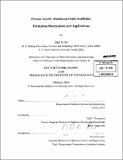Porous anodic aluminum oxide scaffolds; formation mechanisms and applications
Author(s)
Oh, Jihun
DownloadFull printable version (14.30Mb)
Other Contributors
Massachusetts Institute of Technology. Dept. of Materials Science and Engineering.
Advisor
Carl V. Thompson.
Terms of use
Metadata
Show full item recordAbstract
Nanoporous anodic aluminium oxide (AAO) can be created with pores that self-assemble into ordered configurations. Nanostructured metal oxides have proven to be very useful as scaffolds for growth of nanowires and nanotubes with tunable diameters and with tight diameter distributions. For 50 years, field-assisted dissolution of the oxide has been cited as the mechanism that leads to pore formation in alumina, and by analogy, porous anodic TiO₂ and other functional metal oxides. We show that field-assisted dissolution models are consistent with the observed dependence of the Al₂O₃ dissolution rate on the electric field, as well as the existence of a critical field for pore initiation. However, we further show that the well-known ordered porous structure, which has a significantly different length scale, does not result from a field-induced instability, but is instead the result of a strain-induced instability with forced plastic deformation and flow of the oxide during further anodization. We demonstrate that these pore generation mechanisms can be controlled independently, even when they co-exist, by controlling the electric field across the oxide as well as the anodization conditions. We also show that mechanical confinement results in a dendritic pore structure. Through interpretation of these results we develop a generalized mechanism for ordered pore formation in AAO in analogy with cellular solidification. In addition, we report on abnormal behavior in anodic oxidation of Al in mechanically confined structures for formation of horizontal nanoporous anodic alumina oxide, H-AAO. Instead of smooth pore walls, periodic dendrite inner pore structures form, the growth rate is suppressed to 5 % of its value during bulk anodization under the same conditions, and a steady-state is never reached. These anomalies associated with formation of H-AAO originate from suppressed volume expansion and plastic flow of Al₂O₃ confined by the SiO₂ hard mask. By determining new anodization conditions leading to zero volume expansion, dendritic H-AAO can be avoided and kinetic retardation can be minimized. A new method for perforation of the AAO barrier layer has been developed, based on anodization of Al/W bilayer films on substrates. When Al/W bilayer films are anodized and pores approach the Al/W interface, tungsten oxide forms and penetrates the alumina barrier oxide, in part, due to enhanced plasticity of the alumina layer. By selectively etching the tungsten oxide, the barrier oxide can be removed and the base of the pores opened, without etching of the AAO. Finally, we further refined the selective barrier perforation process using the W interlayer to develop a methodology for fabrication of through-pore AAO scaffolds on any conducting substrate (AS) by anodizing an Al/W/AS tri-layer. Structural and kinetic study of the WO₃ extrusion revealed that the anodization of W consumes a fixed thickness of the W layer in acidic electrolytes under specific anodization conditions. Based on this study, the optimum thickness of the W interlayer in the Al/W/Au tri-layer was measured for various anodization conditions. Through-pore AAOs were fabricated on Au layers with exposure of the surface at the base of the pores, using the optimum W thickness without a violent O₂ evolution reaction and without changing the pore diameters. With scaffolds made using this methodology, vertically-aligned free-standing Au and Pt nanowires with diameters ranging from about 12 nm to about 120 nm were grown by electrodeposition on a gold substrate.
Description
Thesis (Ph. D.)--Massachusetts Institute of Technology, Dept. of Materials Science and Engineering, 2010. Cataloged from PDF version of thesis. Includes bibliographical references.
Date issued
2010Department
Massachusetts Institute of Technology. Department of Materials Science and EngineeringPublisher
Massachusetts Institute of Technology
Keywords
Materials Science and Engineering.